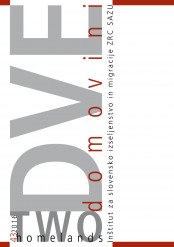Croatian Ethnic Associations in Slovenia: Historical Context and the Ethnic Situation
DOI:
https://doi.org/10.3986/dd.2016.1.09Keywords:
Slovenia, Croatian ethnic associations, ethnic situation, national minoritiesAbstract
Croatian Ethnic Associations in Slovenia: Historical Context and the Ethnic SituationThe article discusses the institutionalized form of Croatian ethnicity in Slovenia. It focuses on ethnic gatherings at Croatian ethnic associations, where eleven existing associations have been combined in a union as an umbrella organization. We used the survey questionnaire method with the leaders of the Croatian associations, and the discourse analysis method for newspaper and internet articles on the issue of the Croatian national minority in Slovenia. Using the ethnic situation model, we attempted to examine them in a wider historical-spatial perspective. The ethnic situation is a theoretical-observational model, which enables putting the observed ethnic situation into an appropriate synchronic (spatial) and diachronic (historical) context. The activities and organizational structure of the Croatian ethnic associations are mostly conditioned by and correlate to the ethnic situation in Slovenia as the host society, but also to the wider surrounding region and the European Union.
Downloads
References
Appadurai, Arjun (2008). Strah od malih brojeva [Fear of Small Numbers]. Belgrade: Biblioteka XX vek.
Badiou, Alain, (2005). Being and Event. London: Continuum.
Barth, Fredrick (1969). Introduction. Ethnic Groups and Boundaries: The Social Organization of Boundaries of Culture Difference. (ed. F. Barth). Oslo: Universitets, 9–38.
Bateson, Gregory (1979). Mind and Nature: A Necessary Unity. New York: Dutton.
Berger, Peter L. and Luckmann, Thomas (1992). Socijalna konstrukcija zbilje [The Social Construction of Reality]. Zagreb: Naprijed.
Collins, Randall (1983). Sociological Theory. San Francisco: Jossey-Bass.
Dilthey, Wilhelm (1980). Zasnivanje duhovnih nauka [Introduction to the Human Sciences]. Belgrade: Prosveta.
Eriksen, Thomas H. (2004). Etnicitet i nacionalizam [Ethnicity and Nationalism]. Belgrade: Čigoja štampa.
Geertz, Clifford (1973).The Interpretation of Cultures. New York: Basic Books.
Ivanjko, Šime (1997). Organiziranost i položaj Hrvata u Sloveniji [Organization and Status of Croats in Slovenia], Hrvati u Sloveniji [Croats in Slovenia], (ed. Mirjana Domini), Zagreb: IMIN, 255–265.
Kralj, Ana (2008). When Ć becomes Č: Discrimination of unrecognized national minorities in Slovenia. Revija za sociologiju 39/4, 235–250.
Luhmann, Niklas (2001a). Društveni sistemi [Social Systems]. Sremski Karlovci - Novi Sad: Izdavačka knjižarnica Zorana Stojanovića
Luhmann, Niklas (2001b). Znanost društva [The Science of Society]. Zagreb: Politička kultura.
Luhmann, Niklas (2011). Društvo društva [The Society of Society]. Zagreb: Breza.
Medved, Felicita (2009). From Civic to Ethnic Community? The evolution of Slovenian citizenship, Citizenship Policies in the New Europe. Expanded and Updated Edition. (ed. Baubock, Rainer; Perchinig, Bernhard and Wiebke Sievers. Amsterdam: Amsterdam University Press, 305–338.
Parsons, Talcott (1949). The Structure of Social Action. New York: Free Press.
Perić, Marina (2005). “Procesi integracije hrvatskih imigranata u Sloveniji” [Processes of integration of Croat immigrants in Slovenia]. Društvena istraživanja 78–79/4, 743–755.
Ploštajner, Zlata (2000). Autochthonous and Newly-Formed Minorities: Two Different Approaches. National Minorities in South-East Europe: Legal and social status at local level, Zagreb: Friedrich Ebert Stiftung, 84–93.
Sartre, Jean Paul (2006). Bitak i ništo: ogled iz fenomenološke ontologije [Being and Nothingness: An Essay on Phenomenological Ontology]. Zagreb: Demetra.
Thomas, William Isaac and Thomas, Dorothy (1928). The Child in America: Behavior Problems and Programs. New York: Knopf.
Vukić, Aleksandar (2008). Moć klasifikacije: klasifikacijske sheme i konstrukcija etničke strukture u Banskoj Hrvatskoj i Slavoniji (1785.–1860.) [The Power of Classification: Classification schemes and construction of the ethnic structure in the Kingdom of Croatia and Slavonia (1785-1860)]. Migracijske i etničke teme, 24/1–2, 31–48.
Zorn, Jelka (2009). Slovenia: Ethnic exclusion in a model accession state. Minority Rights in Central and Eastern Europe (ed. Bernd Rechel). Abingdon, Oxon and New York: Routledge, 210–224.
Žagar, Mitja (2001). Položaj i prava nacionalnih manjina u Republici Sloveniji [Position and rights of national minorities in the Republic of Slovenia], Politička misao, 38/3, 106–121.
Žitnik Serafin, Janja (2013). Organiziranost, delovanje in prihodnji izzivi slovenskih društev v drugih delih nekdanje Jugoslavije [Organization, actions and coming challenges of Slovenian associations in other parts of former Yugoslavia]. Dve domovini / Two Homelands 37, 41–52.
Downloads
Published
How to Cite
Issue
Section
License

This work is licensed under a Creative Commons Attribution-NonCommercial-NoDerivatives 4.0 International License.
Authors guarantee that the work is their own original creation and does not infringe any statutory or common-law copyright or any proprietary right of any third party. In case of claims by third parties, authors commit their self to defend the interests of the publisher, and shall cover any potential costs.
More in: Submission chapter





